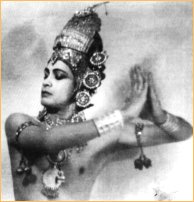 |
  |
 |
  |
Ram Gopal (1912 - 2003) by Ashish Mohan Khokar, Bangalore Photos courtesy: The Mohan Khokar Dance Collection, attendance 2001 e-mail: khokar1960@gmail.com October 16, 2003  He died on Sunday the 12th of October, quietly in sleep and at peace with the world, in London, one of his many homes in the world. A world he dominated from the time he stepped on stage at behest of the Yuvaraj of Mysore, in 1928, and continued to rule as India's Nijinsky, until the sixties. Bissano Ram Gopal was born in Bangalore on 12th November to a Burmese mother and a Rajput father. His parental home - the Torquay Castle - in Benson town, was a palatial mansion with swimming pool and tennis courts, befitting the stature of his barrister father but Ram was not interested in legalities of life but more in the mysteries of movement.  Trained in Bharatanatyam by two giants of the time - Guru Meenakshisundaram Pillai and Guru Kattumanarkoil Muthukumaran Pillai - and in Kathakali by Kunjukurup and Vallathol Narayanan Menon himself presiding at Kalamandalam. For Kathak, he was trained by Guru Jailal and Sohanlal. Ram was one of the first to team up with women dancers like Tara Chaudhri, Shevanti, Mrinalini Sarabhai, Retna Mohini- Bresson, M K Saroja and later with Kathak dancers like Kumudini Lakhia. He created travelling dance companies the likes of which the world, especially Europe, had not seen although he gave credit for his inspiration to the other light of his times, Uday Shankar, whose example had preceded Ram's by a decade. La Meri, the American ethnic-dancer "discovered" his true potential and took him on in 1936 as a dancing partner on his first tour and since then Ram traveled the world many times over. Polish critic Tadeus Zelinski called him the "Nijinsky of India" while Cecil B De Mille introduced him to Sol Hurok. Feted and fawned upon, he was like an Indian god come alive. Ram Gopal's magic lasted far beyond his few active dancing years he had. He performed in some of best-known theatres of the world, including The Grand Theatre, Opera House in Poland; the Palais du Louvre and Muisee Guimet in Paris, the Aldwych in London and the Town Hall in Stockholm where the Nobel Prize Ceremony is conducted. He also immortalized himself through two films made on him: "Aum Shiva" and "Ram" by the famous French filmmaker Lamorisse. David Lean was planning a film based on Ram's life and the script and shooting were in progress when Lean died. The last record of Ram in India is captured on a digital film by Ashish Khokar in 1998. Ram Gopal leaves no student of merit but that's because of my theory (and study) that all great masters don't have students, only followers or copycats. The lives of several masters like Uday Shankar, Ram Gopal, Bala, Sitara Devi, M K Saroja, Vyjayanthimala, Kamala Laxman and many more (including top musicians) shows that great performing artistes need not necessarily be great gurus or teachers. Their art is a gift of the gods, which begins and ends with them. Ram Gopal is no more but lives on in mind and eye of those who saw him stride this planet. He was the king of dance - Nataraja indeed! Till her death five years ago, French patroness Claude Lamorisse, looked after him. Pamela Cullen was his support in London during his end years when he lived in an old-age home. That India did not even bestow a national honour on him shows what India is about (the Sangeet Natak's belatedly made him a Fellow in the late eighties), although the Queen of England gave him an (OBE) Order of the British Empire, a few years ago. But for this king of the dance world, the beauty of movement and its manifestation was its own award. With Ram, a whole era has ended. Hey Ram! Ashish Mohan Khokar is the official biographer of Ram Gopal, in addition to having written over twenty books on arts and culture besides being the editor and publisher of Attendance - India's only yearbook on dance. He is also a well-known critic and columnist (The Times of India, First City, Life Positive) and a commentator for India Today and Managing Trustee of India's largest archives on dance, The Mohan Khokar Dance Collection. He lives in Bangalore presently. |